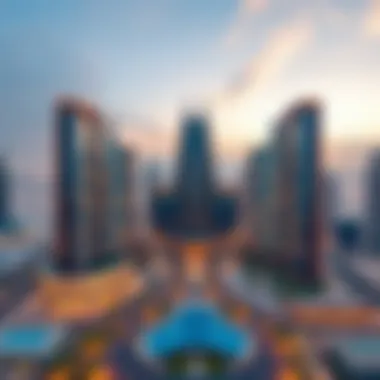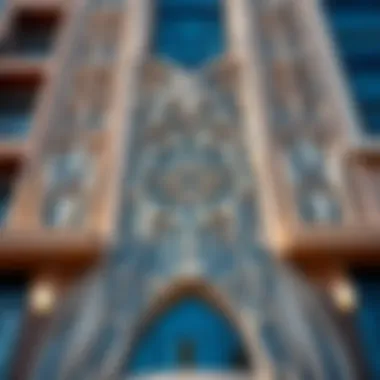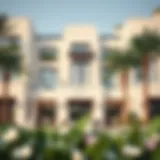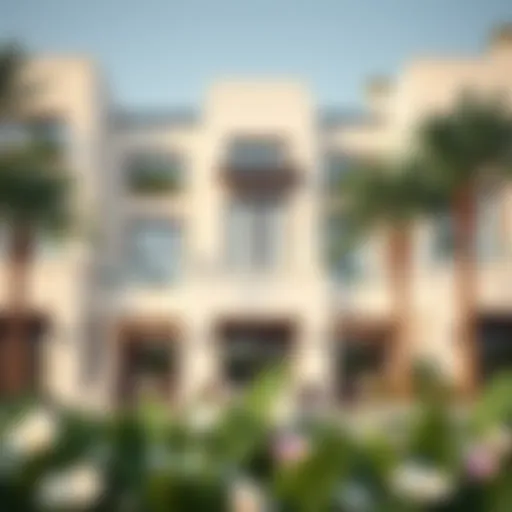Al Hamd Building: Architectural and Investment Insights


Intro
The Al Hamd Building stands as a testament to modern architecture and a symbol of growth in Dubai's real estate landscape. As urban centers continue to evolve, understanding the architectural significance of such landmarks and their potential as investment opportunities becomes paramount. This article aims to peel back the layers of the Al Hamd Building, exploring its design intricacies, the advantages of its location, and the investment climate that surrounds it.
For potential investors and real estate aficionados, grasping the market dynamics and architectural brilliance can be the key to making informed decisions. The Al Hamd Building is not merely a structure; it embodies the essence of a thriving community and a burgeoning economy. Let's delve into the particulars that define its standing within Dubai's intricately woven skyline.
Prelude to Al Hamd Building
The Al Hamd Building stands as more than just a structure in Dubai; it represents a multifaceted convergence of architectural brilliance and investment potential. In the current real estate landscape of the city, where skyscrapers soar and designs challenge the conventional, understanding the significance of this building becomes ever more critical.
Nestled in a strategically dynamic location, Al Hamd Building has managed to capture the essence of modern urban living while also upholding traditional values. This article seeks to unpack not only the architectural features that make the Al Hamd Building a noteworthy landmark but also the strategic advantages it offers to investors.
Importance of Architectural Analysis
To appreciate the depth of Al Hamd Building, one must delve into its architectural design and the influences that shaped its creation. The building integrates aesthetic elements with structural innovation, creating an environment that is not only pleasing to the eye but also functional. By examining its design principles, we can better grasp how the building contributes to the local skyline and the urban fabric of Dubai.
Investment Opportunities
Moreover, alongside its architectural significance, potential investors will find that the Al Hamd Building presents a robust opportunity within the real estate market. With the fluctuating market trends and fluctuating economic conditions, understanding the role of this building as a beacon of investment can help stakeholders make more informed decisions. The combination of its location with the current climate of Dubai's real estate sector presents a unique landscape for investment.
"Understanding the Al Hamd Building is not just about the bricks and mortar; it’s about its potential to yield significant returns in a vibrant marketplace like Dubai."
In this exploration, we will navigate through various dimensions of the Al Hamd Building, including its historical context, architectural design, location advantages, and market trends. Each aspect will be interconnected, painting a comprehensive picture that appeals to investors, property managers, realtors, and developers alike. By diving deep into this subject, we aim to provide insights that empower our discerning audience, arming them with the knowledge necessary to recognize and capitalize on the building's true value.
Historical Context
Understanding the historical context of the Al Hamd Building serves as a crucial foundation for comprehending its architectural significance and investment potential. When we delve into the origins and evolution of such landmarks, it not only enriches our appreciation of their design but also sheds light on the socio-economic factors that shaped them. In the bustling metropolis of Dubai, where modernity collides with tradition, the historical narrative offers insights into the architectural ethos that drives the city's skyline.
Origins and Development
The roots of the Al Hamd Building are entwined with Dubai's rapid transformation from a small trading port into a global city hub. Originally conceived during the city's early boom in the late 20th century, the building represents more than just reinforced concrete and glass. It stands as a testament to Dubai's aspirations, demonstrating resilience and ambition.
This project was initiated after the Gulf War, amidst a period of cautious optimism in the region. With visionary developers aiming to capture foreign investments, the Al Hamd Building was strategically designed to attract multinational corporations. The construction kicked off in the late 1990s, blending function and aesthetic appeal, signaling the beginning of a new era in Dubai's architectural narrative.
The finalized structure was greeted with acclaim, establishing itself as both a commercial space and a cultural landmark. A key consideration during its development was how it harmonized with adjacent areas—facilitating a seamless integration into Dubai's urban fabric.
Architectural Influences
The architectural influences of the Al Hamd Building reflect a blend of traditional Middle Eastern elements with contemporary design principles. This duality not only serves visual appeal but also instills a sense of place and identity within the global city setting.
Influences can be traced to various sources:
- Islamic Paradigms: The building incorporates subtle geometric motifs that echo traditional Islamic architecture, creating a dialogue between the past and the present. These patterns, now renovated for modern interpretation, enhance the cultural resonance of the structure.
- Modernist Trends: A critical examination reveals a strong influence from modernist masters, such as Le Corbusier or Louis Kahn. Their philosophies on functionalism and simplicity are evident in the streamlined forms and pragmatic layout of the building.
- Sustainability Considerations: As modern architecture increasingly embraces sustainability, the Al Hamd Building exemplifies how historical awareness coalesces with eco-friendly practices. Elements such as energy-efficient glass and water conservation systems echo global architectural trends focused on reducing the environmental footprint.
In essence, the Al Hamd Building stands not merely as an architectural achievement but as a narrative interwoven with cultural implications and economic aspirations. Understanding its origins and architectural influences provides valuable insights into the broader historical trajectory of Dubai as it continuously reshapes its landscape.
Architectural Design
The architectural design of the Al Hamd Building is not just a matter of visual appeal; it’s a blend of innovation and functionality. This section focuses on how these elements come together to create a structure that not only captures the essence of modernity but also serves the community and investors alike. Good architecture enables a building to be functional, sustainable, and a key character in its neighborhood.
Structural Features
The structural features of the Al Hamd Building are a testament to contemporary engineering. Standing tall, the building utilizes reinforced concrete and steel frame technologies, ensuring not just durability, but also the ability to withstand environmental challenges like Dubai's intense heat and occasional high winds.
- Innovative Design: The layout includes open floor plans and high ceilings, promoting natural light and spaciousness which increases the overall appeal for potential tenants.
- Safety Measures: Advanced safety measures, including seismic-resistant designs, ensure that the building will stand the test of time along with creating a secure environment for its occupants.


The foundation employs a deep piling system, providing stability. Most importantly, the load-bearing capacity facilitates future expansions, a consideration that may appeal to a savvy investor.
Aesthetic Elements
Aesthetics is where the Al Hamd Building truly shines. Its façade marries functionality with striking design. Sleek glass panels reflect the sun, reducing internal heat while also providing a modern look that resonates with Dubai’s skyline.
- Color Palette: The colors used are carefully selected to complement the surrounding landscape. Earth tones anchor the building in its environment, making it feel like a part of the community rather than an eyesore.
- Artistic Touches: Local art is incorporated into public spaces within the building, giving a unique flavor. These artistic elements invite both admiration and interest from visitors and locals.
Additionally, green spaces and outdoor designs enhance not just the look but also the lifestyle of residents, aligning with growing trends in urban architecture to create livable spaces.
Materials and Technologies Used
The materials used in the construction of Al Hamd Building reflect a commitment to sustainability and innovation.
- Sustainable Choices: Environmentally friendly materials have become more than just a trend; they’re a necessity. The building incorporates recycled materials and energy-efficient installations, reducing its carbon footprint.
- Advanced Technologies: Smart technology plays a fundamental role in operations—from security systems to energy management, these technologies improve tenant experience and operational efficiency.
Furthermore, energy-efficient glazing helps to minimize heat intake while allowing natural light, which can significantly reduce electricity costs for residents. This focus on modern materials and technologies not only adds value to the building but also attracts a modern clientele focused on sustainability.
In essence, the architectural design of the Al Hamd Building goes beyond mere structure. It embodies a blend of beauty, strength, and foresight that meets the needs of today’s investors and residents.
Location Analysis
The significance of location in real estate cannot be overstated, especially in a thriving metropolis like Dubai, where every neighborhood and building tells a story of economic promise. In the case of the Al Hamd Building, the analysis of its surroundings not only highlights its architectural stature but also underscores its relevance as a worthwhile investment. The right location can enhance property value, attract tenants, and ensure lucrative returns, particularly when linked to key amenities and transportation infrastructure.
Proximity to Key Amenities
Al Hamd Building enjoys strategic placement with respect to vital amenities.
- Retail Hubs: Situated near prominent shopping destinations such as The Dubai Mall, residents have easy access to retail therapy.
- Educational Institutions: Top-tier schools and universities, like the American University in Dubai, are only minutes away, making it attractive to families and students alike.
- Healthcare Facilities: World-class hospitals provide peace of mind to residents, ensuring that healthcare is never far from reach. Facilities like Emirates Hospital and Rashid Hospital are known for their quality and accessibility.
Being close to these features can significantly sway buyers' decisions when considering investment in the property. It leads to a vibrant community, geared for both short-term occupancy and long-term residence.
Accessibility and Transport Links
Navigating through Dubai is relatively straightforward, and the Al Hamd Building is no exception. The importance of good transport connections cannot be ignored. Here’s what makes it stand out:
- Public Transportation: Close proximity to the Dubai Metro allows for hassle-free commutes to various parts of the city.
- Major Roads: With easy access to Sheikh Zayed Road and Al Wasl Road, getting in and out of the community becomes convenient, connecting residents to key commercial areas.
- Airport Access: The building is located within a reasonable distance from Dubai International Airport, appealing to business travelers and expatriates who value connectivity.
The blend of accessibility to transport and nearby amenities not only increases the Al Hamd Building's desirability but also enhances its investment potential. As the area develops, property values may rise, presenting significant opportunities for future gains.
"Location is key in real estate, especially in a fast-evolving city like Dubai where accessibility and amenities drive demand."
This analysis of location speaks volumes about what potential investors and residents should expect from living or investing in the Al Hamd Building area.
Market Trends
Understanding the market trends surrounding the Al Hamd Building is crucial for various stakeholders including investors, property managers, and real estate developers. Insight into these trends helps paint a clearer picture of where the market is headed and what opportunities may arise. The dynamics of the real estate sector in Dubai make it essential to keep an eye on shifts in demand, pricing, and investment potential. With Dubai being a global hub, it draws influential economic factors that ripple through the real estate landscape.
Current Real Estate Climate in Dubai
The current state of the real estate market in Dubai shows resilience, with significant recovery after the COVID-19 pandemic. Properties in central locations like Al Hamd Building have seen heightened interest due to their proximity to vital amenities and infrastructure. Prices have stabilized and even seen slight appreciation, as both local and foreign investors seek out high-demand areas.
Some indicators of the current climate include:
- Price Trends: Flat or slightly rising prices indicate stability.
- Demand: Increased inquiries and transactions in well-located properties.
- Investment Interest: Both domestic and international investors are looking toward Dubai as a promising market.


Impact of Economic Factors
Economic factors significantly influence the real estate market. Fluctuations in oil prices, tourism, and overall economic growth can directly impact property values and rental yields. In recent years, the Dubai economy has diversified away from oil dependency, focusing on tourism, technology, and finance.
Key economic indicators affecting the market:
- Job Growth: Presence of multinational companies encourages job seekers to relocate, thereby increasing demand for housing.
- Tourism: Dubai's status as a tourist hotspot bolsters short-term rental markets.
- Finance and Trade: Robust sectors attract foreign investment and talent, driving up property interest.
Future Growth Projections
Looking ahead, the future of the Al Hamd Building and similar properties appears promising. With ongoing development in infrastructure, like new transport links and amenities, the neighborhood's appeal is expected to increase. Furthermore, as Dubai continues to position itself as a leading global city, demand for residential and commercial properties will likely rise.
Some anticipated trends include:
- Continued Investment in Infrastructure: Enhancements in transport and public services are projected to expand property values.
- Sustainability Focus: Developments are leaning towards eco-friendly designs, which could attract a different demographic.
- Foreign Investment Growth: As global economies recover, an influx of foreign investment into Dubai's real estate is expected.
Investment Opportunities
Investment opportunities related to the Al Hamd Building are not just a mere financial consideration; they are a gateway to tap into the pulse of Dubai's thriving real estate market. This iconic structure stands as a beacon for discerning investors, capturing a slice of architectural innovation and promising financial returns. In a city known for its ever-evolving skyline, investing in Al Hamd Building offers distinct advantages that go beyond traditional property investment.
Types of Properties Available
The Al Hamd Building presents a variety of property types that cater to diverse investor interests, from residential to commercial spaces. Here’s a breakdown:
- Residential Units: These typically range from modern apartments to luxury suites. They appeal to both long-term residents and short-term tenants, due to Dubai's flourishing tourism sector.
- Commercial Offices: Designed for businesses looking for prestigious addresses, these offices are strategically located to attract high footfall and corporate clients.
- Retail Spaces: Shops and boutiques within the building offer retail investors a chance to capitalize on pedestrian traffic, capitalizing on Dubai's reputation as a shopping haven.
Each type of property has its own unique appeal and investment potential, allowing investors to match assets with their financial goals and risk appetites.
ROI Potential
When it comes to return on investment (ROI), the Al Hamd Building stands out as a lucrative choice. Key aspects to consider include:
- Rental Yields: The rental market in Dubai is dynamic, with properties in prime locations yielding competitive returns. Al Hamd Building, being centrally located, is likely to offer higher rental yields than properties further afield.
- Appreciation: Dubai's real estate market has demonstrated sustained growth over the years, and properties in well-situated developments often experience significant appreciation. Investing now could mean substantial gains in the future.
- Tax Benefits: Dubai boasts an increasingly favorable regulatory environment for property investors, including low property taxes compared to many other metropolitan areas. This can enhance net returns steadily.
Investors should analyze historical trends and future prospects to intelligently gauge ROI potential and make informed decisions.
Market Comparisons
Understanding how Al Hamd Building fits into the broader market landscape is essential for investment strategizing. Here’s what to look for in market comparisons:
- Similar Developments: Evaluating nearby properties can provide insights into competitive pricing, occupancy rates, and tenant demographics. If similar buildings in the vicinity are thriving, it’s likely Al Hamd Building will follow suit.
- Historical Performance: Analyzing data from past sales and rental prices can give potential investors a peek into market stability and growth patterns.
- Future Developments: Keeping an eye on upcoming projects in the neighborhood can inform how Al Hamd Building’s value may fluctuate. New infrastructure or amenities can dramatically change property desirability.
Investing in properties like those in Al Hamd Building requires a holistic view of the market. By systematically comparing with peer buildings, investors can better anticipate potential risks and rewards.
"The right investment today can secure not just financial growth but also a stake in tomorrow’s skyline."
Investors eyeing Al Hamd Building should continuously update their knowledge on market conditions and regulatory changes, which can impact future investment returns.
Regulatory Environment
Understanding the regulatory environment surrounding Al Hamd Building is crucial for anyone considering an investment in the property. This framework not only sets the guidelines for construction and ownership but also impacts the overall attractiveness of the investment in the long run. Factors such as zoning laws, building regulations, and property ownership laws play an essential role in shaping the opportunities and responsibilities of investors and developers alike.
An investor must thoroughly comprehend these regulations to navigate potential pitfalls and leverage opportunities effectively. Familiarity with local laws can make a noticeable difference in securing a profitable investment. In essence, knowing the rules of the game can tip the scales between success and disappointment.
Zoning Laws and Building Regulations


Zoning laws dictate how land can be utilized and what types of buildings can be constructed within specific areas. In the case of Al Hamd Building, it is imperative to evaluate the zoning classifications assigned to this property. Dubai's urban planning endeavors have aimed to streamline developments, making it easier for investors while also maintaining community standards.
For instance, if the zoning permits commercial use, it could significantly heighten the building's value, attracting businesses eager to establish a presence in this bustling metropolis. Conversely, regulations that restrict certain activities can limit potential income streams, making a thorough understanding essential. Some key points to consider include:
- Permitted Uses: Ensure you know what can and cannot be done in terms of usage.
- Building Height Restrictions: Regulations may impose limits affecting potential airspace and view.
- Density Regulations: Keep track of how many units or businesses can operate within a given area.
Knowledge of these factors can empower investors to make informed decisions that align with their financial goals.
Property Ownership Laws
Property ownership laws in Dubai are particularly noteworthy, especially for foreign investors who often seek to capitalize on the lucrative real estate market. Laws relating to freehold ownership, leasehold agreements, and the associated rights and obligations can greatly affect the experience of owning property in the region.
For Al Hamd Building, understanding the nuances of ownership laws can help demystify the purchase process. In general, foreign nationals can own property outright in designated freehold areas, enabling them to take full advantage of their investment without legal loopholes. However, it is essential to be aware of:
- Freehold vs. Leasehold Agreements: Choose between full ownership of property or leasing it for a specified term.
- Legal Restrictions: Know any legal requirements that may pertain to foreign ownership.
- Transfer Fees and Taxes: Factor in additional costs when calculating return on investment.
"Navigating the regulatory landscape in Dubai is not just about knowing the rules; it’s about understanding how to leverage them to maximize property value and investment potential."
In summary, grasping the regulatory environment surrounding Al Hamd Building is critical for any prospective investor. Zoning laws and property ownership regulations will ultimately define the extent of your involvement, risk, and profit margins. As the city's landscape continues to evolve, staying informed about these regulatory aspects offers a sharper edge in decision-making.
Community and Lifestyle
Understanding the community and lifestyle surrounding Al Hamd Building is essential for grasping its overall significance within Dubai's corporate tapestry. Situated at a strategic intersection of cultural richness and modern living, this building serves as more than just a structure; it embodies the vibrant life that characterizes its locality.
Nearby Residential Projects
The Al Hamd Building is nestled among a myriad of residential projects that cater to various lifestyles and demographics. Among these, notable mentions include The Residences at Marina Gate, which offers luxurious living spaces with captivating views of the Marina. Meanwhile, Jumeirah Village Circle provides more affordable housing options, fostering a community vibe conducive to families and expatriates alike.
- Modern Amenities: Inhabitants relish access to an array of facilities such as gyms, swimming pools, and community parks.
- Walkability: The area is designed to promote walking, connecting residents effortlessly to their daily needs, whether it's shopping, dining, or leisure.
These nearby projects not only complement the professional aura of Al Hamd Building but also enhance its value as a real estate investment. The fusion of residential and commercial spaces in this area promotes a balanced lifestyle, allowing businesses to thrive while offering a homely environment for locals and expats.
Cultural Attractions
Cultural attractions surrounding the Al Hamd Building contribute significantly to the lifestyle in this vibrant hub. These features infuse the area with character and a sense of belonging, making it an appealing choice for potential investors and residents alike.
Among the standout locales is the Dubai Opera, known for its stunning architecture and array of performances, from ballets to concerts. This landmark is a cultural touchstone that brings the community together, enhancing social connections.
Additionally, The Dubai Mall, just a stone’s throw away, is not only a shopping paradise but also a cultural landmark featuring art installations and entertainment options, such as the Dubai Aquarium & Underwater Zoo.
- Art and Heritage Centers: These venues play a crucial role in preserving local culture, making it possible for residents to engage deeply with the tradition.
- Event Spaces: Regular exhibitions and cultural festivals often held in the vicinity promote local artists and encourage community participation.
Overall, the presence of these cultural attractions underscores the appeal of the Al Hamd Building, reinforcing its position as a pivotal element in the community. By offering both residential comfort and cultural engagement, the area promises a lifestyle that is rich in amenities and experiences.
Finale: The Future of Al Hamd Building
As we ponder the future of the Al Hamd Building, it is impossible to ignore the myriad potentialities that lie ahead for this architectural gem nestled in Dubai. This building is more than just a structure; it is a living testament to the city's growth and ambition. Investors, property managers, and realtors should pay close attention to the changing dynamics surrounding Al Hamd, as several key elements will dictate its trajectory in the years to come.
First, the ongoing urban development around the building plays a pivotal role in shaping its future. With further investments in infrastructure, transportation, and amenities, the attractiveness of Al Hamd as a prime location is positioned to soar. A well-connected property, not just in terms of roads but also in terms of community and services, enhances desirability and consequently value.
In addition, economic factors will be significant catalysts influencing the Al Hamd Building's relevance in the real estate market. As Dubai continues to reposition itself as a global hub for business and tourism, the demand for quality properties is expected to remain robust. With continuous growth projections, this can only translate to positive appreciation in property values, a comforting thought for investors contemplating their next move.
Moreover, a unique selling point for the Al Hamd Building lies in its architectural significance and cultural symbolism within the community. The structural integrity, combined with aesthetic considerations, sets it apart from typical buildings. This not only appeals to a niche market of discerning investors but also fosters community pride, giving it an edge in a saturated market.
Investing in properties like the Al Hamd Building is not merely about numbers; it’s about also understanding the pulse of the community and the vision for future growth.
As we look forward, it’s crucial for various stakeholders to consider the sustainable practices being integrated into the newer real estate developments. This aligns with the global trends of sustainability and eco-friendliness, increasing the long-term appeal of Al Hamd. Investors focusing on eco-conscious construction and maintenance will find added value in their investment, appealing to tenant demands in the current market landscape.
Also, consider the competition; understanding the landmarks and developments sprouting in the vicinity will aid in strategizing positions for future appreciation. With potential changes in zoning laws further enhancing the attractiveness of the area, subsequent listings may introduce opportunities that accentuate the significance of the Al Hamd Building.
As such, we can confidently state that Al Hamd is not just a building. It’s a landmark with the potential to thrive, adapt, and become a cornerstone in the ever-evolving skyline of Dubai. Investors, developers, and real estate enthusiasts alike should be energized by its prospects.



